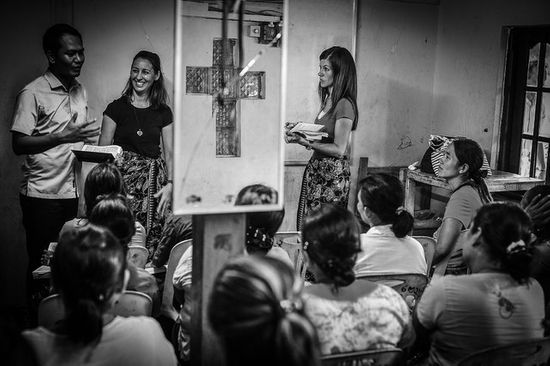Everything You Need to Know About Sabbath School
Sabbath School is the Bible study component of the church program at most Seventh-day Adventist churches. It’s a time of Bible study on a specific topic or lesson. Instead of listening to a preacher, people interact with one another, making it a great opportunity for building friendships.
Your Adventist friend or relative may have mentioned Sabbath School. Or perhaps you saw a sign for it outside a local Adventist Church.
Curious? Let’s walk through the experience together. By the end, you’ll have everything you need to know to try it out for yourself.
We’ll cover:
What is Sabbath School?
Sabbath School is like a small group Bible study that takes place on Sabbath mornings (Saturday) in addition to the main service at an Adventist Church. It’s the equivalent of Sunday school for other Christians, and it’s offered for all ages: from babies to elder adulthood.
Both church members and guests are welcome to take part, learn, and grow in their faith during this time.
So what does Sabbath School entail?
It has three main purposes:
Bible study
 The Adventist church’s motto for Sabbath School is “the church at study.” During this time we dig into the Bible, sharing insights and grappling with challenging topics. The focus is not on having all the answers, but turning to God and seeking the answers in His Word as the Holy Spirit guides us.
The Adventist church’s motto for Sabbath School is “the church at study.” During this time we dig into the Bible, sharing insights and grappling with challenging topics. The focus is not on having all the answers, but turning to God and seeking the answers in His Word as the Holy Spirit guides us.
In this way, we grow in our faith journeys as we share with others and learn from them.
When you attend for the first time, you may want to just observe and listen, and that’s totally fine! But if you want to speak up, your questions and thoughts will enrich the Bible study time. Hearing the experiences and testimonies of others shows us how God is still working in people’s lives today.
Connection
 The Bible says a lot about the importance of community. We need one another. And Sabbath School’s second purpose is to build that sense of community. It’s a great time to interact, get to know one another, and offer encouragement. Being open and honest is key.
The Bible says a lot about the importance of community. We need one another. And Sabbath School’s second purpose is to build that sense of community. It’s a great time to interact, get to know one another, and offer encouragement. Being open and honest is key.
Unlike the main church service time, Sabbath School lets all participants share what’s on their hearts. We don’t just sit and listen to one person speak.
Small groups make this possible. Depending on the church, attendance can be 5-10 people or 20-40 people. Churches in larger areas sometimes split classes to make sure they stay small enough for discussion.
The atmosphere in Sabbath School is much more relaxed so people feel comfortable expressing their thoughts.
Mission
 Churches often use the Sabbath School time to highlight local and global mission projects. In some classes, participants may even band together and reach out to their community.
Churches often use the Sabbath School time to highlight local and global mission projects. In some classes, participants may even band together and reach out to their community.
For example, they might decide to visit people who are sick or volunteer at a soup kitchen on Sabbath afternoon. Or they might pool money together to sponsor a child. There are all kinds of possibilities.
In short, Sabbath School allows us to come together, dig into God’s Word, and serve our world and community. It follows the model of the early Christian church, which gathered in small groups for Bible study and fellowship:
“And they devoted themselves to the apostles’ teaching and the fellowship, to the breaking of bread and the prayers” (Acts 2:42; also verses Acts 2:46–47, ESV).
Jesus Himself taught His disciples in small groups (Matthew 24:3; Mark 9:28), and He promised this:
“For where two or three are gathered in My name, there am I among them” (Mathew 18:20, ESV).
What happens during Sabbath School?
Sabbath School usually begins in the mid-morning hours, anywhere from 9am to 11am depending on the church, and it runs for about an hour and 20 minutes. Most of this time is for Bible study. But at many churches, it starts with other activities, such as song service, a mission report, and prayer.
Let’s go through the full experience.
Sabbath School begins
Most churches begin Sabbath School with a preliminary program with everyone gathered together. But occasionally, the main worship service occurs first, if the pastor has multiple churches to preach at each Sabbath.
And in some larger churches, there are two different church services so they can accommodate all their members. Then there’s time for Sabbath School in between. That way no matter which church service you attend, Sabbath School can still be easily included in your morning schedule.
But for this example, we’re going to walk in the door at 9:30 a.m.—a common Sabbath School start time.
We’ll make our way to the sanctuary—the main auditorium of the church—where the preliminary program is taking place. People typically meet here first.
As we enter, we can already hear the sound of singing. A couple more songs are sung before the coordinator for the morning (known as the Sabbath School superintendent) stands up to welcome everyone and pray. This individual announces that a mission report will be shared next.
The mission report can happen in a couple different ways.
The Adventist Mission department produces a monthly “Mission Spotlight” video, which highlights the church’s mission work in a certain region of the world. The video is 5 to 10 minutes long.
On other Sabbaths, someone might read the assigned mission story for the week from the Youth and Adult Mission booklet.
Afterward, the superintendent makes some announcements, shares a Bible passage, or reads a spiritual thought before dismissing everyone to their classes.
Small group time
The most important part of Sabbath School takes place when small groups gather to dig into God’s Word.
It’s close to 10 a.m. now, which means that the groups will have about 45 to 50 minutes together.
 Some adult classes meet in the sanctuary area, while others have separate rooms. We make our way to a circle of chairs and sit down with a group of about 10 people.
Some adult classes meet in the sanctuary area, while others have separate rooms. We make our way to a circle of chairs and sit down with a group of about 10 people.
Whoever is leading the Sabbath School class will greet everyone, maybe chit-chat a bit, and ask whether anyone has prayer requests. These few minutes of conversation help break the ice and connect the participants.
Then the teacher prays, asking for the Holy Spirit to lead, and we dive into the week’s lesson.
What do we study?
The class might study a certain topic or book of the Bible, or even read through the Bible together. But in many Adventist churches, the teacher will lead a discussion through the Sabbath School lesson study guide.
Let’s learn about that next.
What are the Sabbath School lesson study guides?
 The Adventist Church produces the official Adult Bible Study Guide for use during Sabbath School. It is often referred to as “the lesson” or “the quarterly,” which comes from the word quarter because it’s intended for one-quarter of the year (3 months or 13 weeks). During that quarter, each week’s lesson digs into various aspects of a chosen topic or book of the Bible.
The Adventist Church produces the official Adult Bible Study Guide for use during Sabbath School. It is often referred to as “the lesson” or “the quarterly,” which comes from the word quarter because it’s intended for one-quarter of the year (3 months or 13 weeks). During that quarter, each week’s lesson digs into various aspects of a chosen topic or book of the Bible.
For example, one whole lesson quarterly might focus on the book of Matthew. Another might be on the topic of the Body of Christ, family relationships, the fruits of the Spirit, etc..
The Sabbath School lesson quarterly has one page for each day. The page provides Bible verses for the individual to look up and questions to answer along with some explanation.
Many classes go day by day through the previous week’s lesson and discuss what they learned.
But don’t worry—even if you weren’t able to study the lesson for the week, you’ll still be able to follow along and enjoy the discussion.
 What should I bring to Sabbath School?
What should I bring to Sabbath School?
All you need to bring is yourself and a willingness to learn—really, it’s that simple. But some also like to bring their Bibles and a copy of the quarterly.
The Sabbath School lesson quarterly is usually handed out the Sabbath before the beginning of the new quarter. (Quarters begin in January, April, July, and October).
If you weren’t around to receive one, chances are that there are extras lying around on a table in the church’s entryway. And if not, you can access the Sabbath School lesson online or on a Sabbath School app on your smartphone.
Sabbath School offering
During the Bible study, the teacher may pause the lesson to pass around a couple of envelopes for the Sabbath School offering. An “offering” is a voluntary gift of money to help support various causes in the church. This offering is collected in all the classes, including the ones for children.
You may notice that there are two envelopes. One is for Sabbath School expenses, such as the purchase of Bible study guides.
The other envelope is for the mission offering and goes to support a region of the world church that has been selected for the quarter (the same region that the “Mission Spotlight” highlighted).
But no pressure—you are not required to give.
Giving an offering is up to you and what God places on your heart (Exodus 35:22); it is different from tithe (Malachi 3:10), which involves returning ten percent of our income to God.
What is the 13th Sabbath offering?
 The 13th Sabbath offering is a term for a special collection of money on the last Sabbath of the quarter—the 13th Sabbath. On that day, churches worldwide support a specific mission project chosen by the Adventist Mission department of the General Conference.
The 13th Sabbath offering is a term for a special collection of money on the last Sabbath of the quarter—the 13th Sabbath. On that day, churches worldwide support a specific mission project chosen by the Adventist Mission department of the General Conference.
Aside from the collection of the offering, the children’s classes may put on a special program during the preliminaries. They may present a song or skit that relates to the region of the world where the mission project is located.
Sabbath School is over for the morning
Often you’ll hear some sort of signal at the end of Sabbath School around 10:50 a.m. The main church service will soon begin.
Our teacher makes some closing remarks before wrapping up with prayer. We spend a few moments chatting with people as we gather our belongings and head to find a seat for the main service.
We’ve finished our adult Sabbath School experience, but you may be wondering about the classes for children.
Let’s look at the different options in a typical church.
What are the Sabbath School options for different age groups?
Most Adventist churches have Sabbath School classes for both adults and children. These classes are divided by age or stage of life to provide appropriate content and opportunity for fellowship. There are three main categories: children, youth/young adults, and adults.
But larger churches break these categories up even more.
Occasionally, there are more specific classes for adults: a class for women, a class for college students, or a class for people who are wanting to prepare for baptism.
The children’s classes are also further divided as follows:
- Cradle Roll or Beginners (birth–age 2)
- Kindergarten (ages 3–4)
- Primary (ages 5–9)
- Junior (ages 10–12)
- Earliteen (ages 13–14)
- Teen/Youth (ages 15–18)
So what happens in the children’s classes?
The Adventist Church provides Bible-based materials for each one. Teachers may choose to use these as the basic outline for their classes.
 The Beginners class is the most interactive of all. Usually, the classroom will have decorations and props to match a theme, such as heaven or Creation. Throughout the program, the teacher reads short scripts, interspersed with songs and activities for the children to do.
The Beginners class is the most interactive of all. Usually, the classroom will have decorations and props to match a theme, such as heaven or Creation. Throughout the program, the teacher reads short scripts, interspersed with songs and activities for the children to do.
The class will also have a storytime, using visual aids to catch the children’s attention. Traditionally, many Adventist children’s Sabbath School classes used felt boards—boards on which cloth cut-outs of characters and objects could be placed to tell a story.
The Kindergarten and Primary classes also use play and objects to interact with the children, though by this age, they can understand and participate much more. The teacher might give them pictures to color or crafts to make, too.
As the students become older, the classes shift from hands-on activities to conversing and engaging on a deeper level. The focus is applying the Bible’s principles and stories to the lives of the children and young people in each age group.
For each class—from the smallest children to teenagers—the Adventist Church has produced take-home materials that include age-appropriate Bible stories and character-building lessons.
How to find a Sabbath School near you
Now that you know more about Sabbath School, all that’s left for you to do is experience one in person! The Adventist Church’s website has a useful tool that allows you to find a church in your area. Once you find one, check its website or Facebook page for service times.
You can also bring Sabbath School to your home. Download the Sabbath School lesson at the Adult Bible Study Guide website. This way, you can follow along with what churches across the world are studying. You may even be able to catch the livestream of your local church’s services.
Many online programs follow the same study guide too, providing insight and discussion on the week’s lesson. Here are some of the most popular:
No matter where you are, you can enjoy the blessings of exploring God’s Word!
Sabbath School is for everyone
Sabbath School provides a setting for people of all ages to connect, study the Bible, and fulfill the mission of the worldwide church.
 The Bible study guides help unify people across the globe as they delve into the same lesson.
The Bible study guides help unify people across the globe as they delve into the same lesson.
And the structure of Sabbath School allows people to get to know Jesus and each other better as they come with their questions and thoughts. During this time, friendships can bloom and spiritual growth can happen.
Whether you’re a teen or a young mother or a retiree, there’s a place for you!
That’s what it’s all about:
Joining with others to dig into biblical truths that are relevant to our lives and the mission of sharing Jesus Christ.
Ready to check things out for yourself?
Questions about Adventists? Ask here!
Find answers to your questions about Seventh-day Adventists
More Answers
Why Many Seventh-day Adventists Choose a Vegetarian Diet
Why Many Seventh-day Adventists Choose a Vegetarian Diet?You may have an Adventist friend who is vegetarian, or maybe you’re attending a Seventh-day Adventist Church for the first time and notice the potluck doesn’t have any meat. This isn’t unusual in Adventism. In...
The Health Benefits of Fresh Air You Should Know About
The Health Benefits of Fresh Air You Should Know About“When you can’t breathe, nothing else matters,” the American Lung Association tells us. And while that’s true, the kind of air you’re breathing will determine the health benefits you experience. Breathing fresh...
What Do Seventh-day Adventists Choose to Eat?
What Do Seventh-day Adventists Choose to Eat?Food blogs overwhelm the internet; food fads are all the rage; and copycat and healthy versions of food are the subject of many a get-together. Eating—and eating the best way—is a big deal. And everybody has a different...
10 Incredible Ways Sunlight Can Improve Your Health
10 Incredible Ways Sunlight Can Improve Your HealthAre you concerned about sunlight’s negative effects? You might be the one who lathers on the sunscreen and covers up when you go outside. Or maybe you avoid being outside as much as possible. You might be surprised,...
Why Is Water So Important?
Why Is Water So Important?We all know that water is a substance we can’t live without. It quenches our thirst and keeps us hydrated on the inside. And it’s necessary for hygiene and cleansing on the outside too. But did you know that the cleansing properties of water...
Ellen White’s Writings and the Adventist Health Message
Seventh-day Adventists are known for their emphasis on healthy living. And Ellen G. White was a significant influence in the development of this priority and practice among Adventists.
Health Clinics
Ellen White and Adventist Healthcare—Ahead of Their Time Medical care in the mid-1800s was primitive, to say the least. Basic concepts we take for granted—such as proper handwashing or recognizing the dangers of bloodletting—were nonexistent. And doctors often had...
What Did Ellen White Teach about Vegetarianism?
What Did Ellen White Teach about Vegetarianism?One thing you might have heard about Seventh-day Adventists is their emphasis on a vegetarian lifestyle. If you’re wondering why that is, it goes back to our church’s humble beginnings: As Adventists studied the Bible,...
How Ellen White’s Teachings Can Improve Your Health
How Ellen White’s Teachings Can Improve Your Health Healthcare in the nineteenth century was said to leave “more disease than it took away” with its use of bloodletting and “medicines” like mercury and arsenic.1 As people questioned these methods, new approaches...
Change Your Perspective on Life with These 5 Mindsets
5 Biblical Mindsets to Change Your Life for the Better Sometimes, life is just plain hard. There’s no way around it. So would thinking about things differently really change anything? Our perspective on life, and everything it throws at us, affects more than we’re...
Bible Promises for When You’re Worried or Fearful
Bible Promises for When You’re Worried or Fearful The Bible is full of beautiful promises that can comfort us in a variety of situations. They can give us hope when we are hopeless, make us feel grateful for God’s love, and comfort us when we’re grieving or suffering....
12 Practical Ways to Overcome Worry
12 Practical Ways to Overcome Worry DISCLAIMER: This content is for informational purposes only. It does not constitute any professional medical advice and is not intended as a substitute for professional mental health therapy. It’s easy to get stuck in a cycle of...
How the Bible Talks About Worry, Fear, and Anxiety
How the Bible Talks About Worry, Fear, and Anxiety Worry and fear are the ingredients of anxiety. It’s easy to see how the world isn’t perfect—and the anticipation of a bad event or experience (that may or may not even happen) can end up draining the peace and...
How to Calm Anxious Thoughts, Using the Bible
How to Calm Anxious Thoughts, Using the Bible You were expecting a phone call from your daughter half an hour ago, and she still hasn’t called. She’s also not answering your calls. You feel your heart thumping as your thoughts race: What if she’s been in a car...
What You Should Know About the Adventist Health Studies
What You Should Know About the Adventist Health StudiesYou may have heard that Seventh-day Adventists care about health. But what you may not know is that Adventists have been the subjects of long-term research into lifestyle and health. Since 1958, researchers from...
Benefits of Sunlight
Yes, There Are Health Benefits of SunlightDespite the bad reputation it’s gotten, sunlight is generally associated with positivity, as shown by songs like “You Are My Sunshine,” or phrases that refer to delightful people as having a “sunny disposition.” There’s a...
Why Your Body Needs Rest for Optimal Health
Why Your Body Needs Rest for Optimal HealthStruggling to think straight? Wondering why you can’t remember that important tidbit you heard earlier today? Feeling like your emotions are about to explode? These are just some of the symptoms that can reveal your need for...
The Seventh-day Adventist Diet: One of Our Key Longevity Secrets
The Seventh-day Adventist Diet: One of Our Key Longevity SecretsOats, avocados, lentils, tofu—probably not what you first think of in a standard American diet. But if you show up at the home of an Adventist, chances are you may be served one of these staples. Out of a...
Why You Need Fresh Air
Why You Need Fresh Air“When you can’t breathe, nothing else matters,” the American Lung Association tells us. We couldn’t agree more! Breathing in clean air is an essential part of caring for our bodies, which God has given us. Together with other health principles,...
Sabbath Meal
Everything You Need to Know About Sabbath MealsFor Seventh-day Adventists, sharing a Sabbath meal with friends and family is one of the most special and memorable parts of the Sabbath. That’s why we want to share with you all about Sabbath meals and why they’re such a...
Adventists and Healthy Living
Adventists and Healthy LivingWhat’s the Adventist “Health Message” All About? One thing Seventh-day Adventists are known for is their emphasis on living healthy lives. Since our bodies are living temples of the Holy Spirit (1 Corinthians 6:19, 20), we strive to stay...
Water’s Importance—Physical Benefits and Spiritual Applications
Water’s Importance—Physical Benefits and Spiritual Applications We all know that water is a substance we can’t live without. Not only does it quench our thirst and keep us hydrated from the inside, but it’s necessary for hygiene and cleansing on the outside as well....
How Important is a “Day of Rest?”
How Important is a “Day of Rest?” Why God Created a Day for Downtime by Martin Casper Do you ever experience the feeling of complete overload? Do you feel like the only way you can get ahead is by slamming it 24/7? I hear these types of comments more and more...
7 Reasons Why a Day of Rest is Important
7 Reasons Why a Day of Rest is ImportantWe live in a fast-paced world. It seems as if success is measured in how much you can do in a short amount of time. (Extra points for the service or product that is available 24/7). The idea that we will be more successful if we...
How do Adventists choose what to eat?
How do Adventists choose what to eat?Every day, parents go through the ritual of getting their kids to eat what is healthy and good while trying to steer them away from what can hinder the growth of their developing bodies. Nutritionists work with their clients to...
How Can I Have a Better Marriage?
Is it possible to have a happy marriage?
Why are many Adventists Vegetarian?
Why are many Adventists Vegetarian?The diet intended for man is outlined in Genesis 1:29, “And God said, ‘See, I have given you every herb that yields seed which is on the face of all the earth, and every tree whose fruit yields seed; to you it shall be for food.’”...
Didn’t find your answer? Ask us!
We understand your concern of having questions but not knowing who to ask—we’ve felt it ourselves. When you’re ready to learn more about Adventists, send us a question! We know a thing or two about Adventists.




















